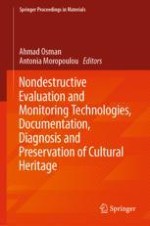2019 | Book
Nondestructive Evaluation and Monitoring Technologies, Documentation, Diagnosis and Preservation of Cultural Heritage
Editors: Prof. Dr. Ahmad Osman, Prof. Dr. Antonia Moropoulou
Publisher: Springer International Publishing
Book Series : Springer Proceedings in Materials
